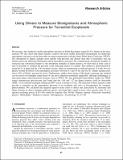Using dimers to measure biosignatures and atmospheric pressure for terrestrial exoplanets
Abstract
We present a new method to probe atmospheric pressure on Earth-like planets using (O-O) dimers in the near-infrared. We also show that dimer features could be the most readily detectable biosignatures for Earth-like atmospheres and may even be detectable in transit transmission with the James Webb Space Telescope (JWST). The absorption by dimers changes more rapidly with pressure and density than that of monomers and can therefore provide additional information about atmospheric pressures. By comparing the absorption strengths of rotational and vibrational features to the absorption strengths of dimer features, we show that in some cases it may be possible to estimate the pressure at the reflecting surface of a planet. This method is demonstrated by using the O A band and the 1.06 μm dimer feature, either in transmission or reflected spectra. It works best for planets around M dwarfs with atmospheric pressures between 0.1 and 10 bar and for O volume mixing ratios above 50% of Earth's present-day level. Furthermore, unlike observations of Rayleigh scattering, this method can be used at wavelengths longer than 0.6 μm and is therefore potentially applicable, although challenging, to near-term planet characterization missions such as JWST. We also performed detectability studies for JWST transit transmission spectroscopy and found that the 1.06 and 1.27 μm dimer features could be detectable (SNR>3) for an Earth analogue orbiting an M5V star at a distance of 5 pc. The detection of these features could provide a constraint on the atmospheric pressure of an exoplanet and serve as biosignatures for oxygenic photosynthesis. We calculated the required signal-to-noise ratios to detect and characterize O monomer and dimer features in direct imaging-reflected spectra and found that signal-to-noise ratios greater than 10 at a spectral resolving power of R=100 would be required.
Citation
Misra , A , Meadows , V , Claire , M & Crisp , D 2014 , ' Using dimers to measure biosignatures and atmospheric pressure for terrestrial exoplanets ' , Astrobiology , vol. 14 , no. 2 , pp. 67-86 . https://doi.org/10.1089/ast.2013.0990
Publication
Astrobiology
Status
Peer reviewed
ISSN
1531-1074Type
Journal article
Collections
Items in the St Andrews Research Repository are protected by copyright, with all rights reserved, unless otherwise indicated.

